► What is a hydrogen car?
► Hydrogen fuel explained
► Are hydrogen vehicles viable?
Hydrogen cars have been pitched as a tantalising glimpse of the future for decades. Usually taking the form of hydrogen fuel cell vehicles, they appeal to the forward-thinking because they promise the holy grail of zero emissions in combination with the kind of driving range and refuelling experience we’re used to with petrol and diesel cars.
Even the very best battery electric vehicles (BEVs – more often known simply as EVs) force you to hang around for at least the length of time it takes to drink a very hot coffee before they gain any meaningful additional driving distance. A hydrogen fuel cell electric vehicle (FCEV) can be driven for hundreds of miles at a time. You can then refuel with hydrogen in a matter of minutes.
What’s more, because they use electric motors as well, the driving experience is very similar to a conventional electric car. The only emissions are water vapour, so they’re much cleaner than petrol and diesel vehicles, too.
How do hydrogen cars work?
We have a separate page dedicated to explaining how hydrogen cars work, but to give you the basics there are two ways hydrogen can be used as a fuel. Most hydrogen vehicles use fuel cell technology, but hydrogen combustion engines are also being explored.
Hydrogen fuel cell cars use the hydrogen in a chemical reaction that generates electricity. This electricity then powers an electric motor that drives the wheels.
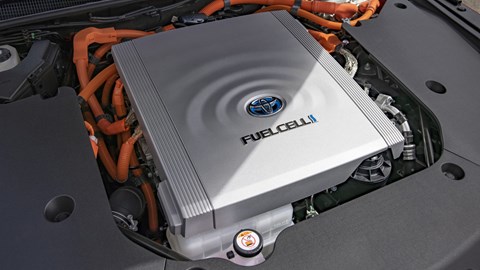
This is similar to a BEV, except that instead of a battery pack there are hydrogen tanks and a fuel cell – known as a fuel cell stack – where the chemical reaction takes place.
Hydrogen combustion cars burn the hydrogen in a way that’s similar to petrol and diesel cars. In fact, most hydrogen combustion vehicles use existing engines that have been converted to run on this alternative fuel.
Hydrogen isn’t as energy rich when used this way, however, so the result tends to have reduced performance compared with the original petrol version. Hydrogen fuel cell vehicles suffer less in this way as their performance is governed by the power of the electric motor.
What is a hydrogen fuel cell?
According to the American Department of Energy ‘A fuel cell uses the chemical energy of hydrogen or other fuels to cleanly and efficiently produce electricity. If hydrogen is the fuel, the only products are electricity, water, and heat.’
This essentially means that it’s similar to a battery, except it won’t run out – as long as there is fuel it will keep producing electricity.
The electricity comes from a chemical reaction involving a catalyst that separates the hydrogen molecules into protons and electrons.
What hydrogen cars are currently available to buy?
You can’t just walk into a showroom and drive one away, but there are two hydrogen cars on sale in the UK from mainstream manufacturers right now: the Hyundai Nexo and Toyota Mirai.
The Hyundai Nexo is an SUV, the Toyota Mirai a swoopy saloon, and both will require a relatively lengthy conversation with their respective manufacturers before you’ll be able to hand over the money. As special factory orders, you’ll be in for a wait of three or four months at least.
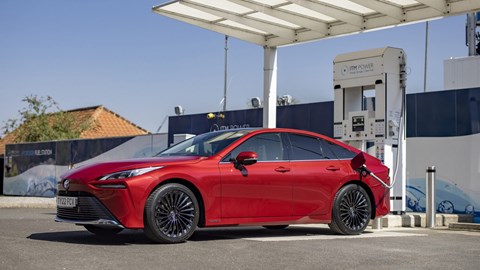
Also worth noting is Riversimple, a British company that’s been working on making hydrogen cars viable since the 1990s. Now based in Wales, the current design is called the Rasa and began public trials in 2020 with a view to future production. There’s a waiting list, if you’re interested.
Other manufacturers experimenting with hydrogen as a fuel include BMW, Honda, Ineos, Mercedes-Benz, Renault and the Stellantis group of companies.
Do hydrogen cars drive differently?
Basically, no – especially if you’re at all familiar with electric cars. Hydrogen fuel cell cars also use electric motors to turn their wheels, so the experience of driving them is very similar.
This means smooth, quiet performance, just like a responsive conventional car with an automatic gearbox. Electric vehicles like these typically have single-speed transmissions, so there are no gears to worry about or cause interruptions in the forward drive.
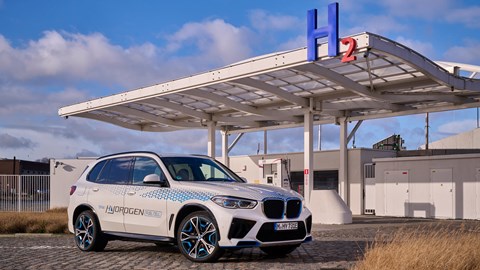
Hydrogen combustion cars will be even more familiar, as they substitute hydrogen for petrol or diesel but use it in the same way. Performance isn’t usually quite as good, and they may sound slightly different – but otherwise the experience is the same.
Are hydrogen cars safe?
Yes, and probably more so than petrol cars. While the famous Hindenburg airship disaster continues to disprove the old saying ‘there’s no such thing as bad PR’, hydrogen cars have a large number of safety systems built-in to prevent accidents.
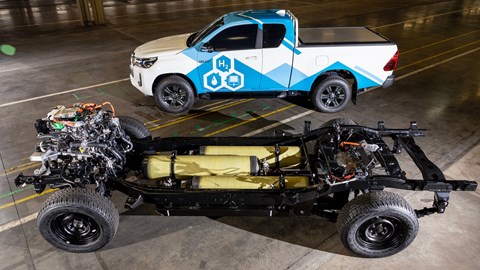
Not only are they packed with sensors for detecting leaks, the tanks that hold the hydrogen are extremely tough – to the extent that they are even designed to withstand being shot at.
What’s more, you can’t refuel a hydrogen car unless the fuel hose is locked on and the system has been pressure tested. Much safer than petrol, which can just be squirted about and is held in comparatively flimsy tanks before being ignited under the bonnet.
What are the pros and cons of hydrogen cars?
Pros:
- Zero emissions while driving
- Quiet and smooth
- Hydrogen is the most abundant element in the universe
- Lots of built-in safety features
- Faster to refuel than electric cars
- Driving range comparable to conventional cars
Cons:
- While abundant, hydrogen still needs to be processed, which isn’t easy
- Not all hydrogen is cleanly produced (it can be a byproduct of the oil industry)
- Fuel cell technology is expensive
- Performance may not be as good as a conventional car
- Fuelling infrastructure is extremely limited (five UK stations suitable for cars at present)
How much does a gallon of hydrogen fuel cost?
Hydrogen is sold by the kilogram, and unfortunately prices tend to fluctuate. There’s also a huge difference in price depending on what part of the world you’re in. With current technology a kilo of hydrogen should be able to power an FCEV for around 60 miles.
In raw terms, it can cost less than £2 per kilo, but this typically isn’t ‘clean’ or ‘green’ hydrogen, which is created using renewable energy sources. For example, the most common ‘grey hydrogen’ can be produced more cheaply as a byproduct of natural gas, or methane, but with no carbon-capture as part of the process it’s much less environmentally friendly.
There’s also ‘blue hydrogen’ (created using the same process but with carbon-capture) and ‘black / brown hydrogen’ (which is formed using coal and is very much not an eco-friendly solution). Other colours on the hydrogen colour spectrum are pink (nuclear), yellow (solar) and turquoise (methane pyrolysis). White hydrogen is naturally occurring.

Green hydrogen, especially when it’s produced in the UK, can be far more expensive – even 15 times as much. And that’s before you add the costs involved with transporting it and running the fuel station, which is also an expensive business.
So although the guidance is usually £10-15 per kilogram of fuel for a hydrogen car, even that may vary depending on the source of the hydrogen. In September 2023, a hydrogen fuel supplier in California put prices up to $36 per kilogram, making it ‘almost 14 times more expensive‘ to refuel a Mirai than a Tesla.
Are hydrogen cars better than electric?
We’ve spoken to a lot of experts within the car industry about this over the years, and the response is always that both electric and hydrogen cars have a part to play in the transport of the future.
Hydrogen is considered a promising long-term solution for long-distance travel, since it’s faster to refuel and can easily deliver hundreds of miles of driving range per tank.

Electric cars have typically been seen as more of a short-term solution better suited to shorter journeys, as they take far longer to recharge and battery capacity is seen as more limiting for longer distances.
Fundamentally, they are both similar in their ability to deliver zero-emissions driving and both are limited by the current state of the technology.
Do hydrogen cars have a future?
This very much depends on whether the demand for long-distance zero emissions travel can be met by future developments in battery electric vehicle technology.
Hydrogen fuel cell cars are expensive to build and would be almost impossible for an ordinary motorist to run one right now due to the very limited number of hydrogen fuel stations. And while governments around the world have committed to improving on this, whether that will happen before advances in battery and charging technology make electric cars even more usable remains to be seen.
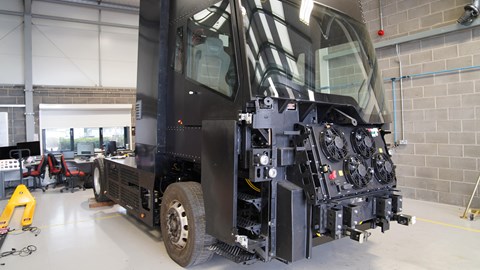
Because there is already an electricity grid to tap into, and because we already have years of experience learning about and using electric cars, it could well be the case that hydrogen cars never really become viable or necessary enough to succeed.
Hydrogen is looking useful for long-distance trucking, however, where the weight of the batteries required for a BEV would have an impact on payload and carrying capacity. Toyota has also built a prototype hydrogen-powered Hilux pickup.
You can read more about this on our dedicated page that asks: are hydrogen cars the future?
What is the mileage of a hydrogen car?
Taking the currently available Hyundai and Toyota models as the obvious examples, the Nexo is officially capable of 62 miles per kilogram of hydrogen while the Mirai is a little more efficient at around 69 miles per kilogram.
According to WLTP figures, that makes the Mirai equivalent to well over 300 miles per gallon of conventional fuel. By the same measure, the Nexo’s official range is 414 miles per tank, and it can be refilled in just five minutes.
CJ Hubbard is a former CAR associate editor and now runs parent-company Bauer’s digital automotive content hub. In a ‘professional’ writing career that began back in 2006, he’s driven everything from tiny electric cars to articulated trucks, and is as happy discussing the importance of bump stops in suspension tuning as he is explaining the latest tech innovations.